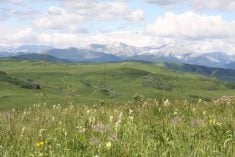SCOTT, Sask. – Placing canola seed in the icy hands of Mother Nature for a long winter’s sleep may be risky, but for those who do, the payoff can be worth the gamble.
Testing that goes as far back as 1975 into the viability of fall seeding spring canola varieties has often met with the same results: Problems with weed control and emergence, plus fall plant kills.
These have prevented farmers from getting that earliest start to their canola crops. Winter canola varieties have never fared well in the West due to winter temperatures and traditionally dry conditions.
Read Also

Selenium not deal breaker in coal mining: expert
Environmental scientist weighs in on coal mining debates in Western Canada, explaining selenium and the technologies and practices to lower its concentrations in nearby waterways to coal mining operations
But herbicide-tolerant transgenic canola has changed the practicality of fall seeding. Ken Kirkland, of Agriculture Canada, has been testing the latest in seed with the earliest in seeding practices for several years at this experimental farm in west-central Saskatchewan.
Planting in late October or early November when soil temperatures are low enough to inhibit germination allows the seed to stay dormant through the winter.
Planting of seed resistant to glyphosate, glufosinate ammonium and imazethapyr types of broad spectrum herbicides has conquered the competitiveness of annual winter weeds that heavily damaged canola yield. The three registered canola varieties available are Roundup Ready, Liberty Link and Pursuit Smart.
Total wild oats control
Roundup Ready canola was used in Kirkland’s tests and he reports 100 percent control of wild oats, wild mustard, cow cockle and cleavers when spraying was done at canola’s three-leaf stage. Only one application of herbicide was needed because the young canola plants were able to compete well enough on their own after the early- weed kill.
Kirkland found positive results flowing from the canola’s strong early resistance to late spring frosts as low as -8 C, and emergence dates in late April and early May.
Early flowering in the fall-seeded canola has yielded both larger seed size and higher oil content due to lower temperatures during blossoming. Canola yields in testing have been about 1,600 kilograms per hectare or 28.5 bushels per acre, slightly less than crop seeded in late April or early May and marginally better than crop seeded in mid May.
Despite early growth, flea beetles still attacked the plants on warm days in May, but overall, beetle damage and injury from bertha army worms and diamondback moths were reduced.
“The new varieties are better able to produce from a late fall seeding. Seeding earlier in the fall will hurt the crop as any plants that germinate will be lost,” said Eric Johnson, of Saskatchewan Agriculture.














